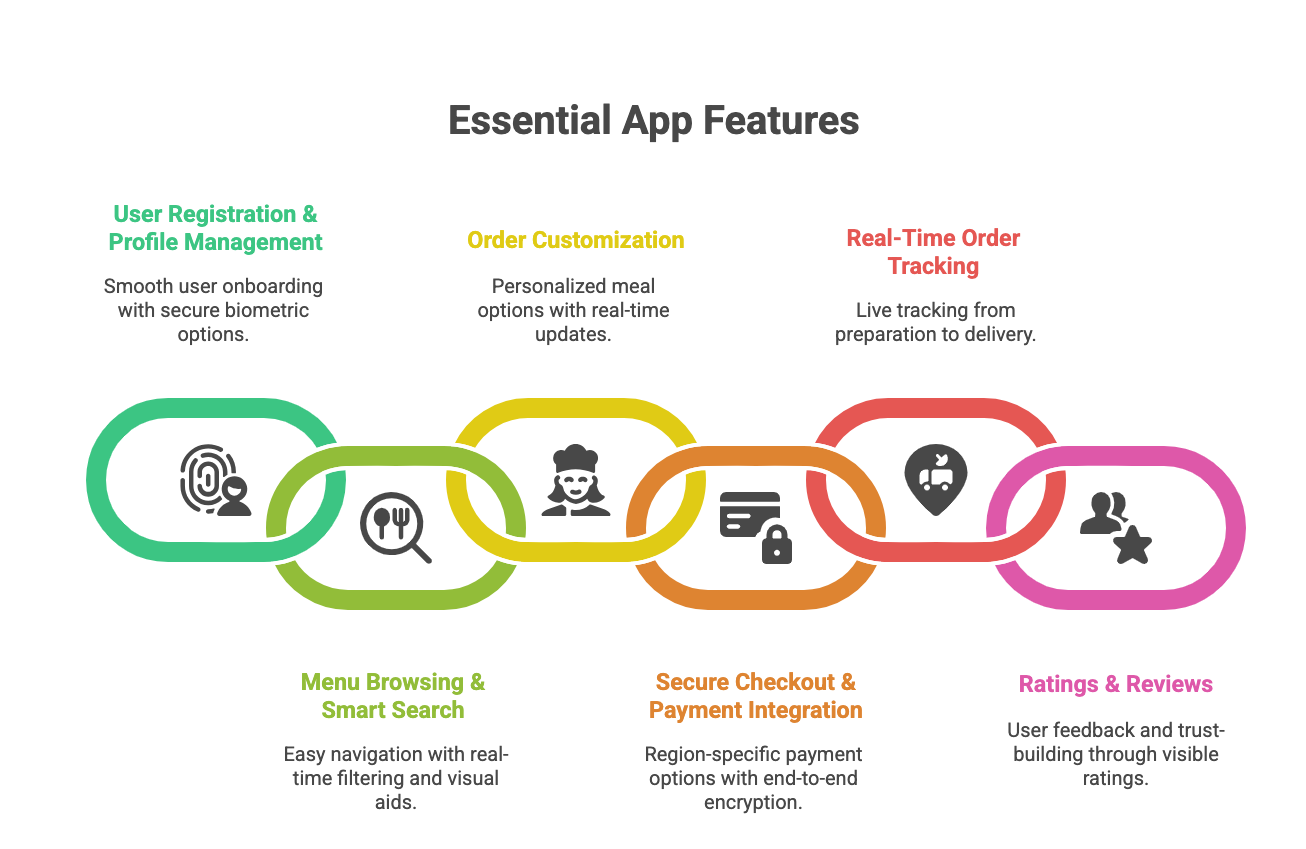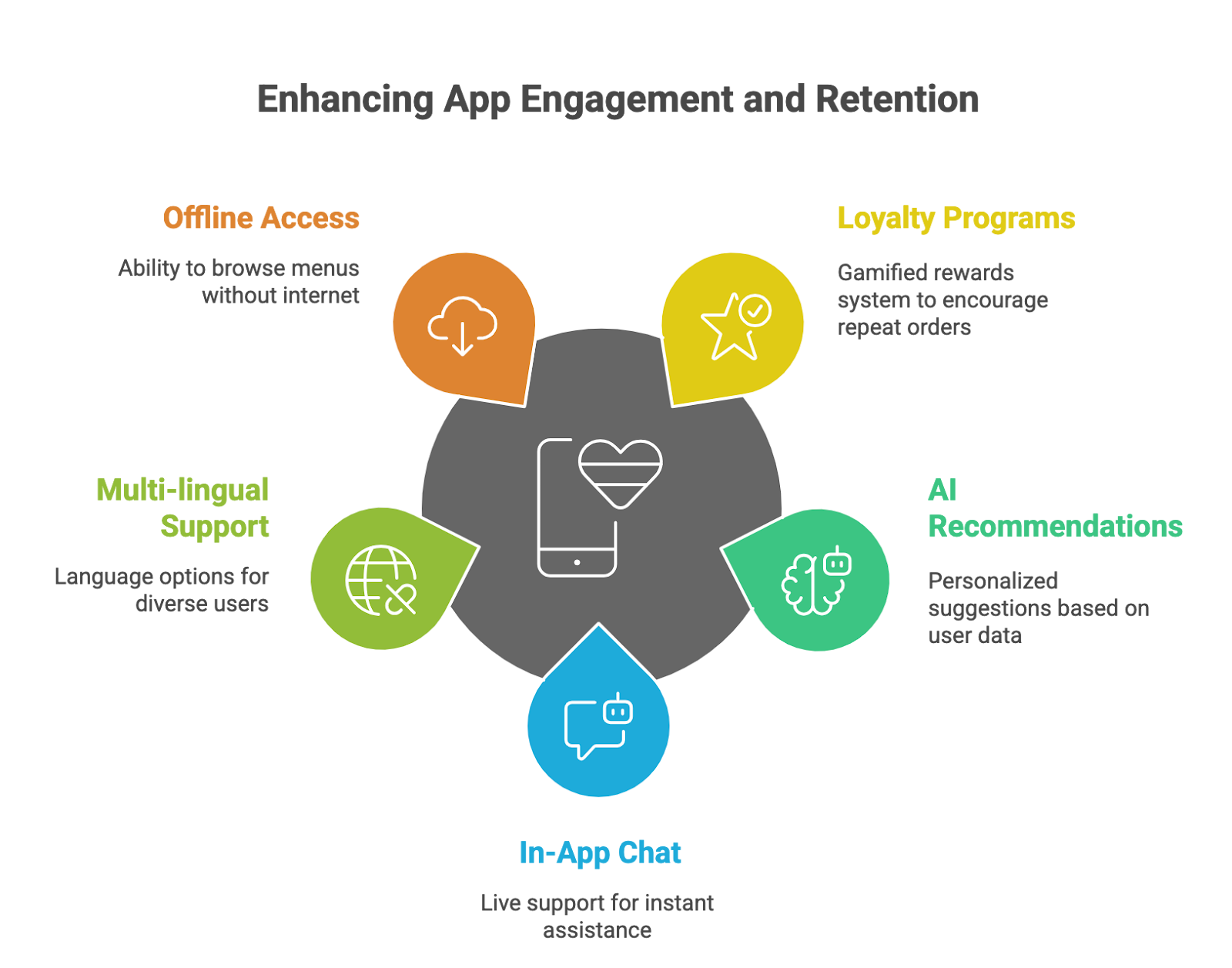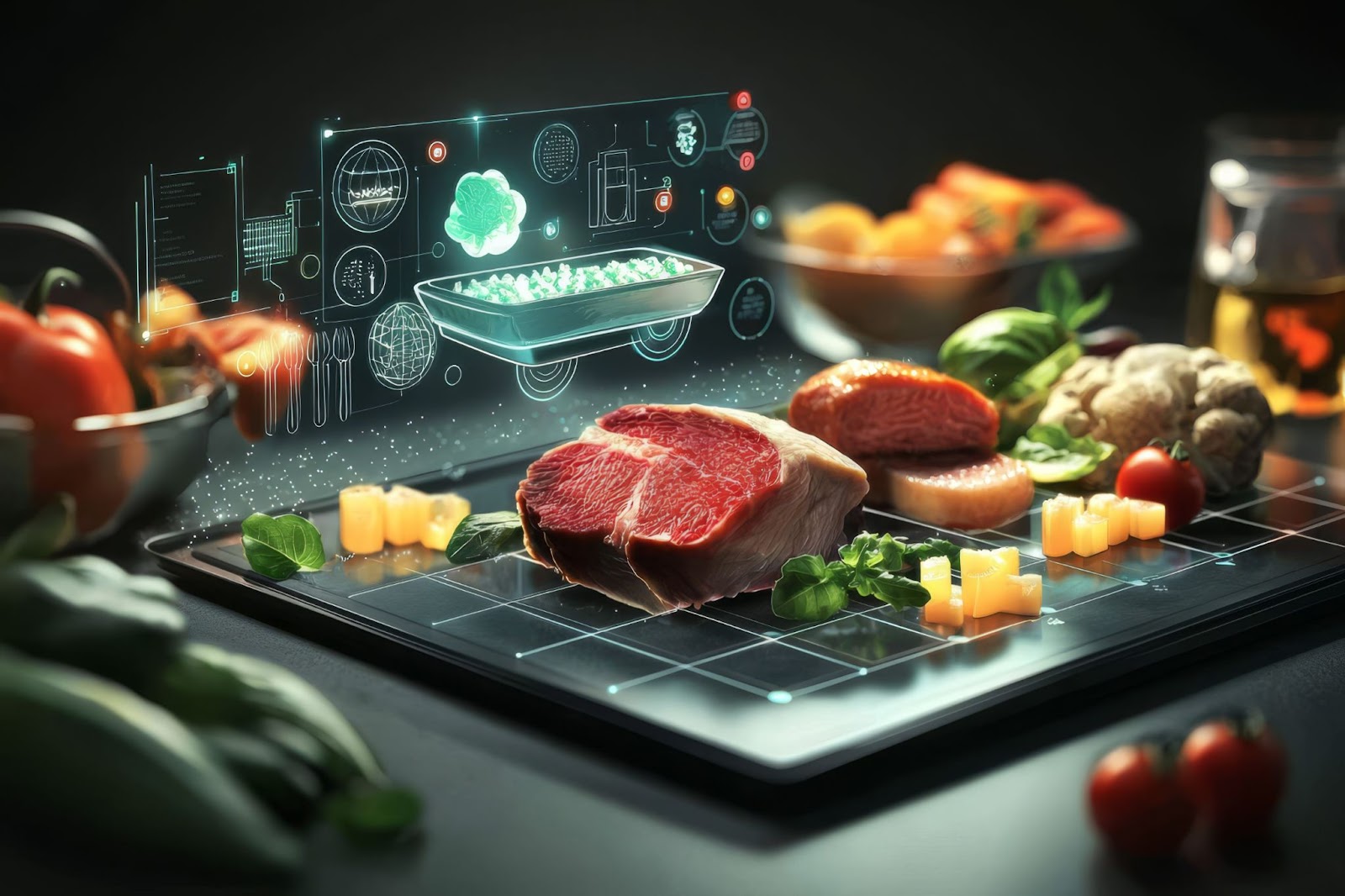|
Getting your Trinity Audio player ready...
|
Food and beverage industry in the Gulf is facing a massive revolution in digital terms. In 2025, the online food delivery market in the UAE and Saudi Arabia is expected to skyrocket by about 60% with the growth in mobile penetration and lifestyle changes and, most importantly, after a preference for hedonistic digital dining. Leading by example is the UAE, with a digitally savvy populace, while Saudi Arabia, under Vision 2030, is encouraging innovation in hospitality.
A dedicated mobile application is no longer optional; it is now considered crucial for attracting customers through effective channels, creating operational efficiencies, and achieving brand loyalty. With either a delivery, sit-down, or take-out mobile-first strategy, the Gulf technology surveys show revenue increases of as much as 40%.
This comprehensive guide will provide extensive information on the market landscape, user requirements, essential and advanced features, technology stack, development process, costs, and monetisation strategies—all tailored to fit the dynamic Gulf environment optimally. So, let’s go about discovering how to build the winning food app of the future in this region.
Market Overview & Opportunity
The other two most digitally advanced economies of the MENA region are notably those of the UAE and Saudi Arabia. The food delivery market in these two countries is growing at an exponential rate. “The online food delivery business in the Middle East is expected to reach USD 9.3 billion by 2025, with the UAE and KSA having substantial shares due to reasons such as high smartphone penetration, urban density, and youthful populations,” states Mordor Intelligence.
The food delivery culture is anchored in the UAE, with over 98% of the population owning a smartphone and almost 70% of residents ordering food through apps at least once a week. Saudi Arabia benefits from a youth population (over 60% under 30) and Vision 2030 initiatives, which have sped up the development of eCommerce and digital innovation, mainly in the areas of restaurant and cloud kitchen delivery.
The major players in the market include Talabat, HungerStation, CareemNOW, and Deliveroo, but there is a gap for specialised apps that appeal to healthy and halal consumers or promote leisurely opportunities for tourists to discover local cuisine.
Customers are demanding real-time tracking, loyalty rewards, and multilingual interfaces. Those restaurants that harness this new digital opportunity will not only meet changing demands but will also significantly increase the likelihood of their business’s survival in an intensely competitive mobile-first food economy.
User Personas & Pain Points
To create an app that truly resonates with its target audience, it is imperative first to understand the target audience. Below are major user personas in the Gulf restaurant app ecosystem:
- Busy Professionals (age group 25-45): These professionals, who work in fast-paced finance or tech environments, rely on quick lunch ordering and delivery. Scheduled delivery appears as the most requested attribute, along with saved payment methods and corporate discount codes.
- Families (30-50): Mostly ordering dinners and family meals for weekends; group ordering is of prime concern to them, besides options for children’s food, bulk discounts for family-size meals, and order history for reordering.
- Tourists and Expats: Tourists in town searching for authentic local food appreciate the multilingual interface, geo-based recommendations, and rapid delivery around landmarks.
Main Pain Points:
- Wrong order or late order
- Unclear menu specifications or dietary filters
- A slow-performing app or app that crashes
- Localized payment methods are unavailable
- The app fails to provide the expected loyalty rewards.
Addressing these issues with effective UX/UI considerations, feature-rich designs, and context-based customisations will lead to the app’s success.
Core Features
Basic features are the building blocks for your app, the ones that every user will look for and depend on. Let’s discuss in detail:

- User Registration & Profile Management
Users can register smoothly using social logins, email, or mobile number with OTP, and they also have access to payment options available in the add-on payment type app. Offer biometric feature options like Face ID or fingerprints for added security.
- Menu Browsing & Smart Search
Make navigation easy across the menu with labels such as “Breakfast,” “Vegetarian,” or “Under 500 Calories.” Give smart tags that will help in filtering availability in real-time, with visual representation through menu cards and a description of dishes.
- Order Customization
Let customers customise their meals by adding and removing ingredients or listing allergens. Include “Build Your Own Dish” for salads, wraps, or pizzas, with updates in real-time on calorie counts and costs.
- Secure Checkout & Payment Integration
Provide region-appropriate options like STC Pay, Mada, Apple Pay, PayTabs, and Telr, aside from credit and debit cards. Implement end-to-end encryption, and let users store their preferred payment means.
- Real-Time Order Tracking
Give the ability to track the order from kitchen preparation to delivery using a map with ETA updates. Order-status notifications and the use of live GPS enable transparency at the final mile.
- Ratings & Reviews
A user can vote on each dish in addition to voting for the overall service. Please highlight the top-rated items and address the negative comments. Trust is established through visible ratings and user pictures.
These are the features that together make up the backbone of a delightful user journey, improving conversion and retention.
Advanced Features
The importance of advanced features, along with visibility, is not comparable to making an app stand out in an overcrowded market like the Gulf app market. These features are not mere utilities; they foster relationships through engagement, personalisation, and retention.

- Loyalty & Rewards Programs
Online gamified loyalty program. For orders, users earn points at different phases (Silver, Gold, and Platinum) to get advantages like free delivery or a specific dish. Send a push for points expiry or special rewards.
- AI Recommendations
Machine learning makes recommendations from historical orders at the time, while differentiating between
- Dietary patterns
- Local festivals or the weather
- This aspect allows you to engage with a personalised experience for repeated use.
- In-App Chat & Support
The live chat feature is integrated with human agents and AI chatbots to provide answers to frequently asked questions, as well as instant assistance for order issues, menu queries, or refunds.
- Multi-lingual Support
Support both Arabic and English, Hindi and Urdu, and Tagalog. For a seamless user experience, it is also necessary to incorporate an RTL layout and region-specific icons.
- Offline Access & Instant Reorder
The system should cache past menus or orders for offline browsing. The One-Tap Reorder-in feature allows for easy reordering while travelling or when there is limited connectivity.
These features contribute to longer session durations, a decrease in churn, and improved brand affinity.
Technology Stack
Developing a restaurant application that’s quick, scalable, and reliable means selecting the right tools. The following is a stack optimised for the Gulf market:
For the Front-End (Mobile UI/UX)
- React Native: Speeds up development for both iOS and Android under a shared codebase.
- Flutter: Best for smooth animations and localised UIs, providing Arabic RTL support.
Back-End (For Logic & APIs)
- Node.js with Express.js: Good for real-time API, high efficiency, and rapid development.
- Python Django: Ideal for high-security applications, diverse options for well-built admin dashboards, and potential integrations of ML Modules.
Databases
- PostgreSQL: Designed for structured data such as menus, users, and orders.
Redis: Fast cache supporting real-time operations like menu loading or loyalty points.
Payments
- Telr, PayTabs, Mada, STC Pay, and Apple Pay are options for secure and compliant local payments.
Push Notifications
- Firebase Cloud Messaging is used for sending updates about orders, promotional discounts, or loyalty notifications.
Hosting & DevOps
- You can choose either AWS ECS/EKS or Google Cloud Platform for cloud-native, scale-out infrastructure.
- Set up CI/CD pipelines for automated builds, testing, and deployments using Jenkins or GitHub Actions.
This technical stack perfectly balances performance with localisation, which is highly suited to the Gulf’s infrastructure and users’ expectations.
Step-by-Step Development Process

Phase 1: Discovery & Research
Begin with detailed market studies in the UAE and KSA. Conduct user interviews, evaluate leading competitors (such as Talabat and Deliveroo), and prioritise features based on gaps and opportunities.
Phase 2: UX/UI Design
Create the user persona, build wireframes, and develop high-fidelity mockups. Culturally relevant design (e.g.: Arabic typography, halal symbols)
- RTL compatible
- Accessible and optimized for touch
Conduct user testing on the prototypes to gather feedback before proceeding with development.
Phase 3: MVP development
Create a minimum viable product with core features:
- Registration
- Browsing menus
- Checkout
- Basic order tracking
Agile sprints with biweekly milestones, code reviews, and test-driven development (TDD) should be followed.
Phase 4: Integration of Advanced Features
After the MVP launch, AI features like smart recommendations and loyalty engines might need to be integrated. Multilingual support, chat features, and deep analytics should also be added.
Phase 5: QA & Testing
Test across all dimensions:
- Functional testing for the menu flows and payment processing.
- Security testing for data encryption and API protection.
- Performance testing for load testing under high traffic.
- Localisation testing for ensuring translations and RTL formats.
Phase 6: Go-live & Marketing Preparation
For the launch preparation, consider:
- App Store Optimization (screenshots, Arabic/English descriptions, keywords)
- Soft launch in strategic cities (Dubai, Riyadh)
- In-app feedback tools and usage analytics
The process will not end at launch; continuous updates and support for extending scalability will ensure its long-term success.
Cost Breakdown & Influencing Factors
Restaurant app development costs vary based on complexity, technology, and regional considerations. Here’s a breakdown:
- Design & Prototyping (10–15%)
- This includes UX/UI, user testing, and branding assets.
- Cost: $7,000–$25,000
- Core Development
- Front-end, back-end, and basic features.
- Cost: $30,000–$60,000
- Advanced Features
- The advanced features include loyalty, AI, chat support, and multi-language modules.
- Cost: $20,000–$50,000
- QA & Testing
- Manual and automated tests and localisation checks.
- Cost: $10,000–$20,000
- Hosting & Maintenance
- AWS/GCP fees, updates, bug fixes, and monitoring.
- Monthly: $2,000–$5,000
- Regulatory & Regional Factors
- VAT-compliant invoices
- Mada & STC Pay gateway fees
- Arabic RTL and cultural customization
Estimated Total
- Basic MVP: $70,000–$120,000
- Full-featured app: $120,000–$250,000+
Investing in quality pays off through higher user retention, better reviews, and long-term ROI.
Monetisation Strategies
An application for a restaurant can serve as an effective engine for generating revenue. It works as follows:
- Commission from Orders
If you aggregate orders from multiple restaurants, charge a percentage fee per transaction (5-20%).
- Delivery Charges & Subscriptions
Offer free delivery to a subscriber every month (e.g., Gulf Bites Pro). Have standard delivery fees for use-as-you-go patrons.
- In-App Advertising
Restaurants can sponsor listings or cause dish promotions on the home screen.
- Premium Tools for Restaurants
- Access to Analytics dashboards
- Menu performance reports
- Custom loyalty engines
Paying to unlock multiple earning approaches helps diversify earnings and improve the sustainability of the app.
Common Challenges & Solutions
- Managing increased traffic and scaling
Solution: Use auto-scaling on AWS/GCP, Redis caching, and microservices to prevent bottlenecks. This is particularly important during peak-hour events like Iftar during Ramadan.
- Localisation
Cost: Arabic RTL support, cultural icons, and menu translations.
Solution: Employ a combination of i18n frameworks, hire local translators, and test with native speakers to improve UX.
- Payment compliance
Ensure compliance with PCI-DSS, integration with Mada and Apple Pay, and issue receipts complying with VAT regulations.
- Delivery logistics
Integrate with last-mile partners and optimise the ETA algorithms using real-time GPS and traffic data.
Breaking down these barriers builds trust and reliability in the app.
Why Choose Esferasoft?
At Esferasoft, we have a profound understanding of the Gulf market, combining local expertise with top-notch technical execution.
We have successfully delivered apps for:
- Cloud kitchens in Riyadh
- Fine dining restaurants in Dubai
- QSR chains scaling in Abu Dhabi and Jeddah
Our team consists of Arabic-speaking designers, compliance experts in the region, and AI developers building restaurant apps that additionally scale and are intelligent.
From the idea stage to post-launch support, we offer:
- Custom UI/UX
- Robust tech architecture
- Agile development and QA
- Ongoing maintenance with SLAs
Whether you’re building a brand-new app or upgrading an existing one, Esferasoft will serve as your partner for development from end to end.
Dish Out More Than Food—Deliver Experiences

The F&B industry in the Gulf is digital-first, competitive, and saturated with opportunities. A well-constructed restaurant app could increase revenue, improve customer retention, and future-proof your business.
There lies a clear path from core features to advanced AI, smart UX, and the support most suited to your locale for the development of a high-performing app sometime in 2025.
Are you prepared to transform your restaurant idea into a robust mobile experience?
Esferasoft invites you for a free consultation to understand your business objectives in the UAE and Saudi Arabia and provide a custom quote.

